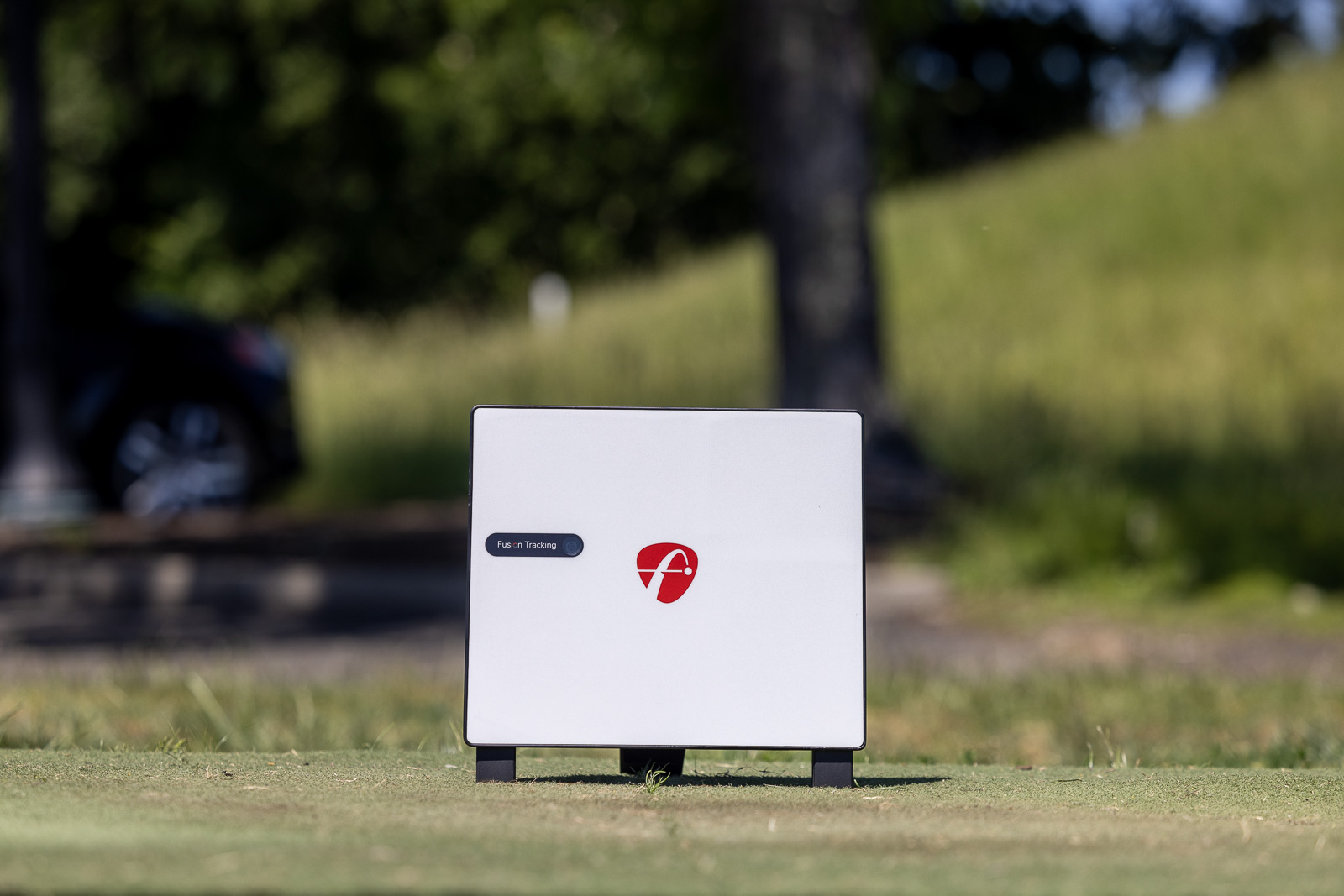Let’s start with a baseline.
I think the FlightScope Mevo+ is the best golf launch monitor value for most people. For the price, it’s really tough to beat.
And one of the things that makes the Mevo+ so remarkable is that it delivers some pro-level features at more of a prosumer price. And the reason behind that is the Mevo+’s larger, more expensive, more robust sibling, the FlightScope X3C.
In essence, the Mevo+ is a stripped-down version of the X3C. Except for the fact that it’s not that actually stripped down. Keep reading.
You can buy a Mevo+ and add the Pro Package and Face Impact Location for about $2,800 (maybe less on a good sale with the code BREAKINGEIGHTYPLUS). The X3C is going to run you $13,500
And that’s the big question: Is the X3C really worth the $10,000+ premium?
That’s what we’re digging into in this review.
I’ve spent time testing both the Mevo+ and the X3C side by side. And while the X3C is clearly the more powerful unit on paper — it’s heavier-duty, tracks more data, and has some unique perks — it’s not automatically the better buy for everyone.
In this post, I’ll break down the key differences between these two models, highlight the new features FlightScope recently added to both devices, and help you decide which one might actually be right for you.
If you’re in the market for a premium radar-based launch monitor, this one’s for you.
What Is the FlightScope X3C?
Before we go too deep, let’s clear up what the FlightScope X3C actually is.
This is FlightScope’s top-tier, pro-level launch monitor. It’s the model designed to go head-to-head with the likes of Trackman and the GCQuad. It’s built for serious performance, and it’s most commonly found in teaching studios, clubfitting bays, or commercial setups.
But if you’re a gear-obsessed golfer who wants the best of the best, and you want something that can work both indoors and outdoors, the X3C might be on your radar too.
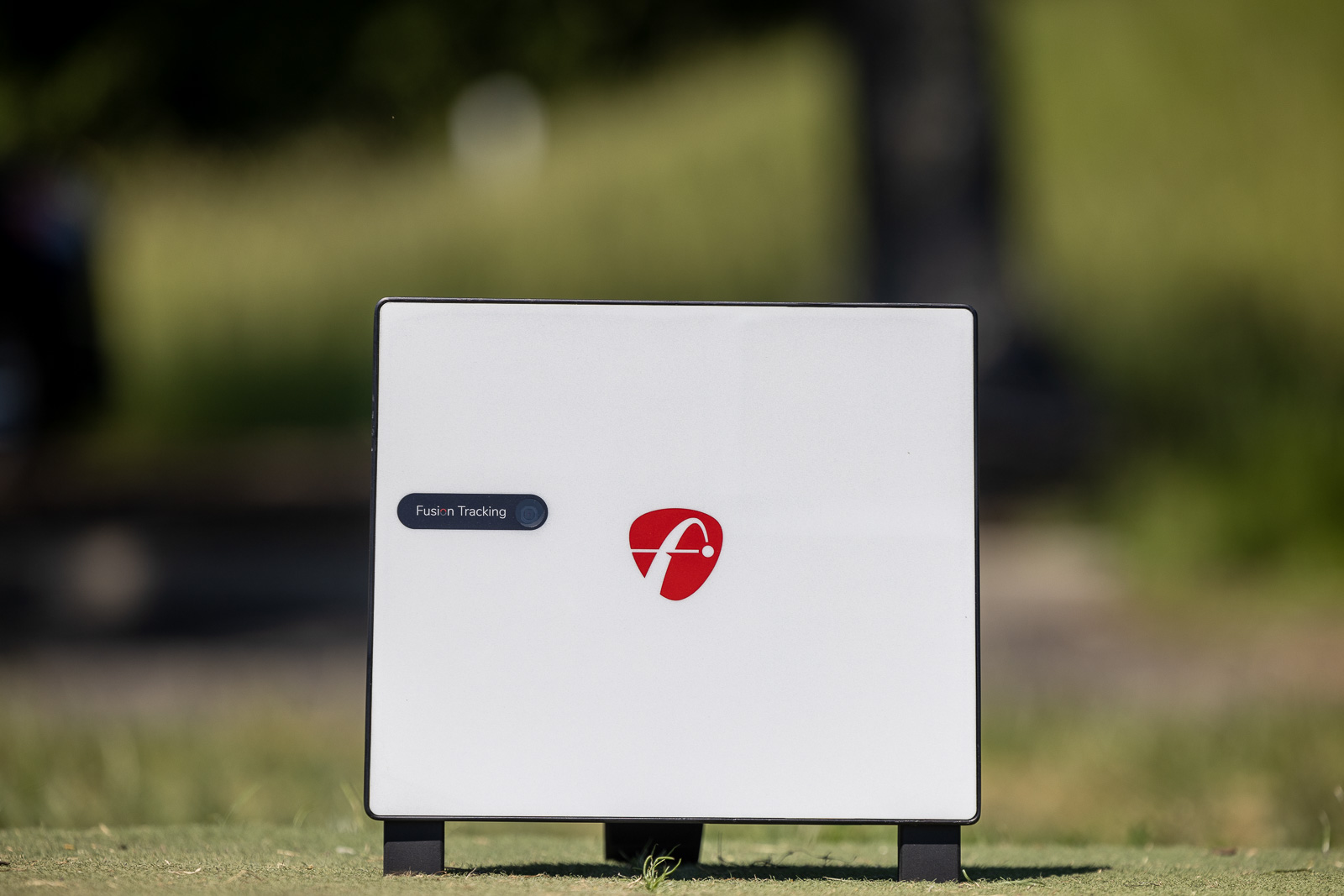
But even if you are considering an X3C, it’s worth considering how much of the X3C is already available in the form of the much more accessible Mevo+.
Since the release of the Mevo Plus, FlightScope has slowly been porting some of the X3C’s features over to their more affordable consumer model. And that’s a big part of why the Mevo+ represents such insane value.
Case in point: Fusion Tracking.
A few years back, FlightScope introduced Fusion Tracking to the Mevo+. It combines Doppler radar data with camera-based input to deliver more accurate, consistent results. The tech originally debuted in the X3C.
Fusion Tracking is awesome. It works great. And I was genuinely impressed when they rolled it out as a free update to Mevo+ users.
All that to say, it’s interesting to see just how many of the features have trickled down to the Mevo Plus.
First Impressions of the X3C
Let’s start with the basics: the X3C is essentially an updated version of FlightScope’s original X3. The core functionality remains the same, but the X3C introduces a few tweaks, most notably, the all-new carbon fiber body.
Now, I’ll be honest: I’m not entirely sure what practical advantage a carbon fiber shell gives you in a launch monitor. The unit is still heavy. It’s not like this update suddenly made the X3C portable or easy to carry around.
But it does look cool. The carbon fiber finish gives it a high-end, professional vibe right out of the box.
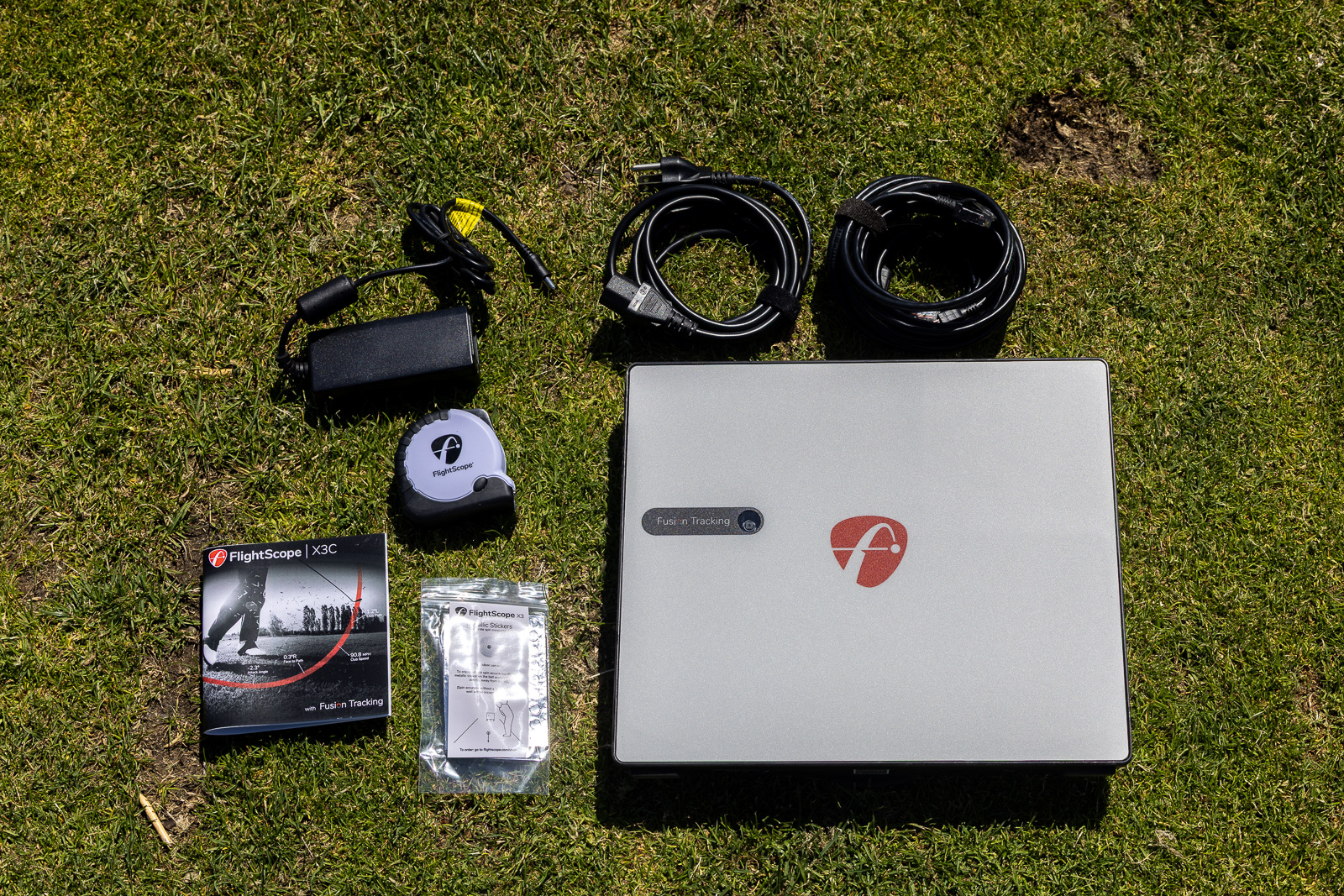
That said, one thing that felt a little disappointing, especially for a device that costs more than $10,000 and just got refreshed, is that it’s still using a mini USB port. No USB-C. Same as the Mevo Plus.
While that’s not a dealbreaker from a performance standpoint, it is a mild inconvenience in 2025, considering nearly every cable I own now is USB-C.
The good news: Charging is otherwise excellent. Unlike the Mevo+, which uses USB for power, the X3C comes with a dedicated DC charger.
The battery is rated for about five hours, and in my testing, I’ve used it across three range sessions without needing a recharge. So if you’re the type to grind out long outdoor sessions, the X3C is built to keep up.
Out of the box, it feels premium. You get everything you need to get started: the unit itself, a set of club data stickers, a USB cable, an Ethernet cable, a power adapter, and even a FlightScope-branded tape measure for getting precise setup distances.
But the feature that might make the biggest quality-of-life difference?
Auto-leveling.
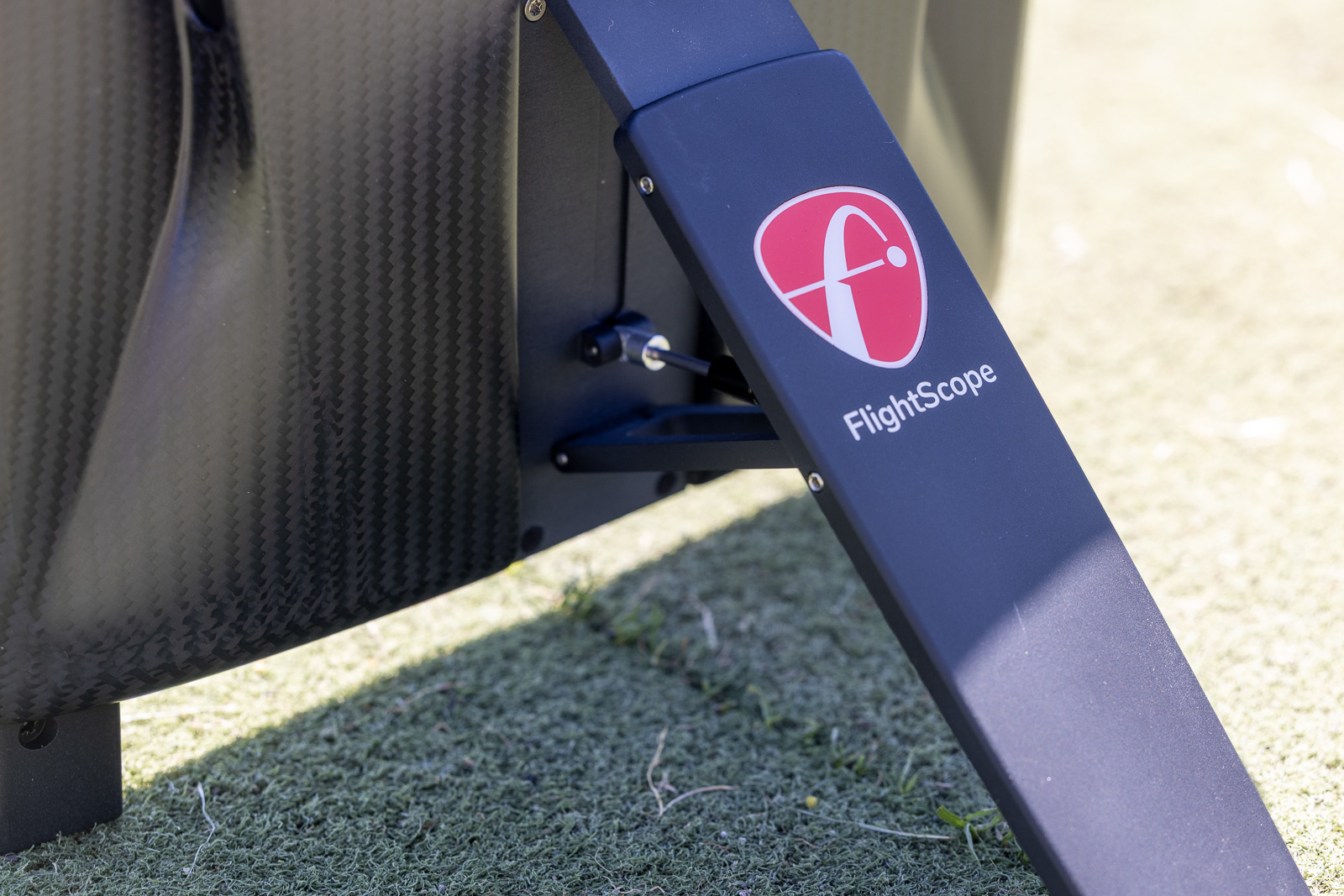
This is one of my favorite touches that separates the X3C from the Mevo+. With the Mevo+, you’re relying on a built-in kickstand. If the surface behind your hitting area isn’t perfectly level, getting everything lined up can be a hassle. It’s one of my biggest gripes with that model.
The X3C solves that cleanly. Flip the stand down, power it up, and the unit auto-levels itself. No manual adjustments needed. It’s a very cool and very useful feature.
There's absolutely no denying that the FlightScope X3C is an incredible launch monitor. The question though: Is it really more than $10K better than the also-awesome FlightScope Mevo+?
Same App, Better Hardware
One of the best parts about upgrading to the X3C, especially if you’re coming from a Mevo+, is that everything still runs through the same FlightScope app.
This might seem like a small thing, but it’s actually a big win for usability. If you’ve logged dozens (or hundreds) of sessions on your Mevo+, all of that data is still accessible. You’re not learning a new interface. You’re not rebuilding your shot history. You’re just plugging in new hardware.
It’s a smooth transition, and it makes the X3C especially appealing for anyone already familiar with the FlightScope ecosystem.
From a value perspective, that familiarity is a big reason why the Mevo+ continues to impress. It gives you access to a professional-grade app and user experience, even though the hardware lives at a much more approachable price point.
There are a couple downsides, however.
One is that their cloud system isn’t great. As of now, if you record a session on your phone, you can’t then easily get that same data into the FlightScope app on your iPad (and vice versa). You can login to your FlightScope account via a browser and get it all, but the interface isn’t great, and why would anyone want to do that when the app works so well?
This is probably my single biggest request from FlightScope for future updates.
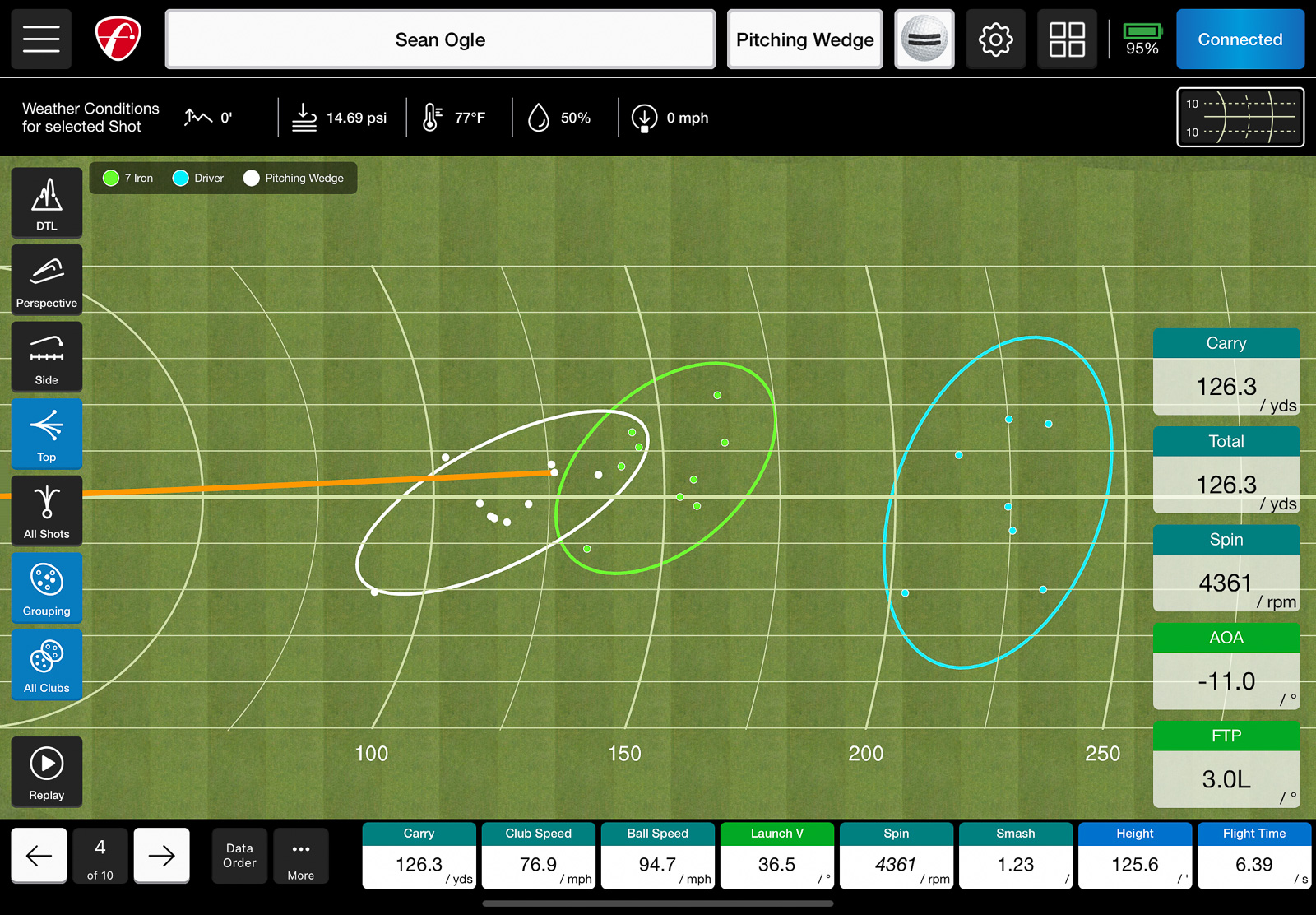
The second is that the app does feel a little dated at times. Some of the design is starting to show its age. Despite that, it’s still one of my favorite interfaces across any launch monitor platform.
Why?
Because it’s super customizable. You can tweak how your data shows up, switch between metric sets, visualize your sessions in a bunch of different ways, and you get access to a broader range of shot data than you will with almost any unit short of a Trackman.
Bottom line: If data matters to you, FlightScope delivers. And having that same power available whether you’re using a Mevo+ or an X3C is a huge advantage.
One Frustrating Setup Quirk, Finally Fixed
Historically, one of my biggest gripes with FlightScope devices — both the Mevo+ and the X3C — has been the WiFi setup process. And if you’ve used one with an iPad that doesn’t have a cellular connection, you probably know exactly what I’m talking about.
Here’s the issue: To connect the app to the device, you have to join the WiFi network that the launch monitor emits. But once you’re connected to that, your iPad can’t also connect to the internet.
That means if you want to do something like download a course in E6 or access any other online feature, you have to disconnect from the launch monitor’s WiFi, connect to your home WiFi, grab the data, then go back and reconnect to the launch monitor.
It’s tedious, clunky, and just kind of annoying.
But that problem has now been fixed.
In a recent firmware update, FightScope introduced WiFi sharing, and it’s a game-changer.
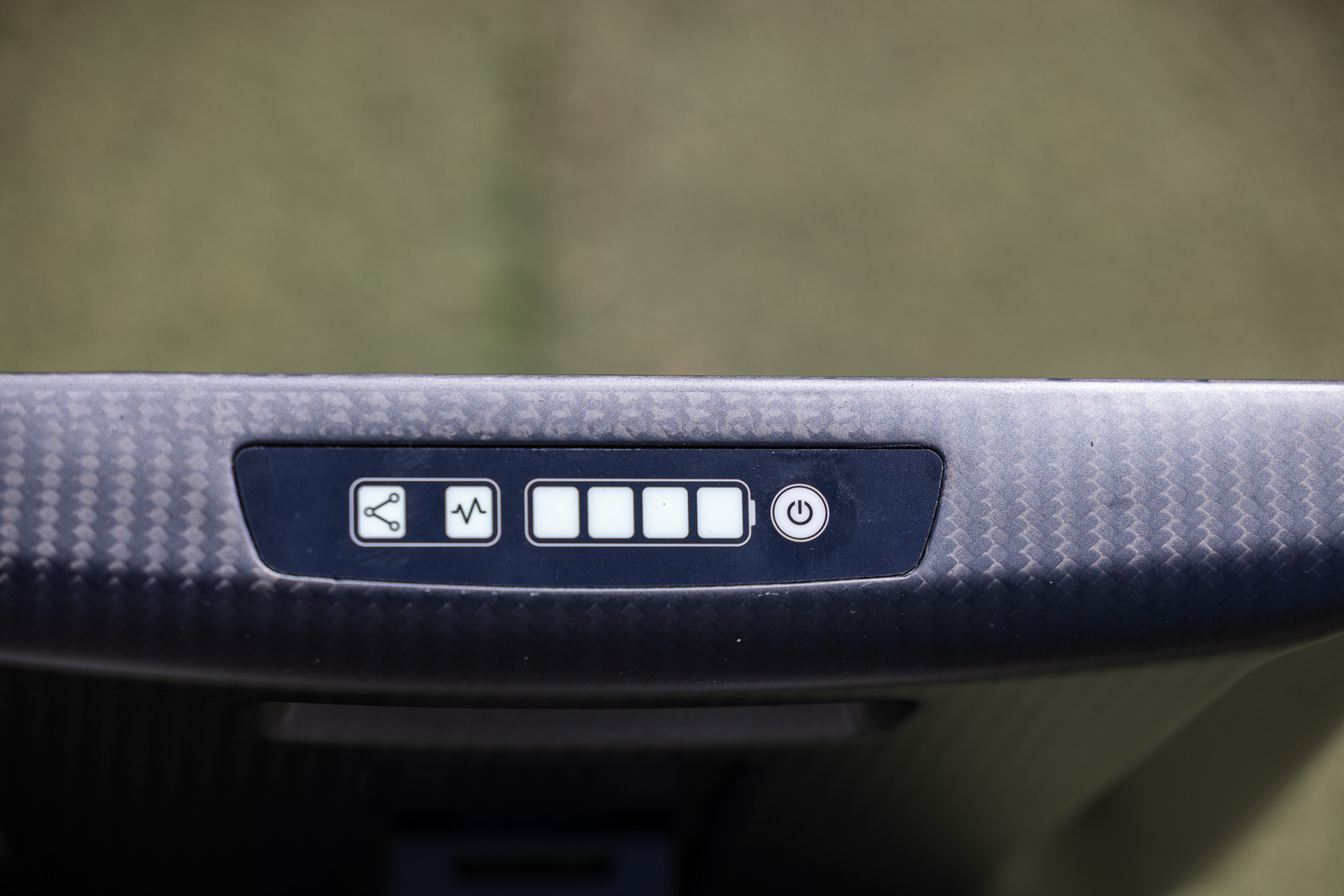
Now, both your iPad and the FlightScope device can be connected to the same WiFi network at the same time. That means no more bouncing back and forth between connections, no more setup workarounds, and a far smoother user experience overall.
There are also two other major FlightScope updates, which I’ll get to in just a couple of minutes.
X3C vs. Mevo+: Usability and the Tradeoff of “More Accurate”
In terms of day-to-day usability, the FlightScope X3C works just like the Mevo+. And that’s honestly one of my favorite things about it. If you’ve used a Mevo+, jumping into the X3C feels totally familiar. Same app, same core flow, just a more advanced device behind the scenes.
But there is one thing you’ll notice if you’re using the X3C outdoors, and that is that it takes a little longer to for your shot data to display.
At first, that might sound odd. Shouldn’t the more expensive unit be faster?
Well, not in this case. And there’s a good reason.
The X3C uses a more powerful Doppler radar system that actually tracks your ball all the way to the ground.
With the Mevo Plus, the radar captures the first 150-ish yards of flight and then relies on algorithms to project the rest of your shot data. That gives you faster feedback, but technically, it’s estimating the tail end of the flight.
With the X3C, there’s no estimation. It tracks the full shot. Which, in theory, gives you more accurate data. But it also adds a second or two of processing time after each swing.
So here’s the tradeoff. If you’re a teaching pro or someone who needs pinpoint accuracy, that slight delay is worth it. But if you’re like me, someone who values speed and fluidity during a practice session, the quicker feedback from the Mevo Plus is actually kind of preferable.
And just to be clear: In my testing, the numbers from the Mevo+ and the X3C have been pretty similar. Close enough that, for most amateur players, the difference in precision probably isn’t worth the five-figure jump.
X3C Delivers More Putting Data, But Do You Need It?
Feature-wise the X3C and the Mevo+ (with the Pro Package upgrade) are pretty evenly matched when it comes to chipping metrics. You’re getting a ton of data with both.
It’s worth noting that the X3C does a much better job at consistently capturing chips – especially if you’re hitting into a net. This is something the Mevo Plus can occasionally struggle with.
And once you get to putting, the X3C really starts to pull away.
Even the Mevo+ Pro Package can’t give you everything. It skips things like club speed, roll distance, and roll speed for putts. Meanwhile, the X3C captures all of that and more.
How much that matters to you is an individual question and depends on how you plan to use it. If putting work is a major part of your sim setup, then those added metrics might justify the upgrade. The X3C gives you more detail and more accuracy.
But for me? I’m not doing a ton of putting work on a launch monitor. And if you’re more focused on full swing practice or simulation rounds, those extra short game numbers may not move the needle much.
Still, it’s a nice bonus to have, especially if you want the most comprehensive data set possible.
Live Shot Tracer, Finally Fixed (and Actually Useful)
Let’s talk about one of the coolest — and now most improved — features FlightScope has rolled out recently, the Live Shot Tracer.
If you’ve ever watched a PGA Tour broadcast and seen that smooth ball flight tracer follow a tee shot down the fairway, you know what I’m talking about. It’s a clean, satisfying visual. And for a long time, FlightScope was the only consumer-facing launch monitor brand that could replicate that effect in real time, using live video footage from your own swing.
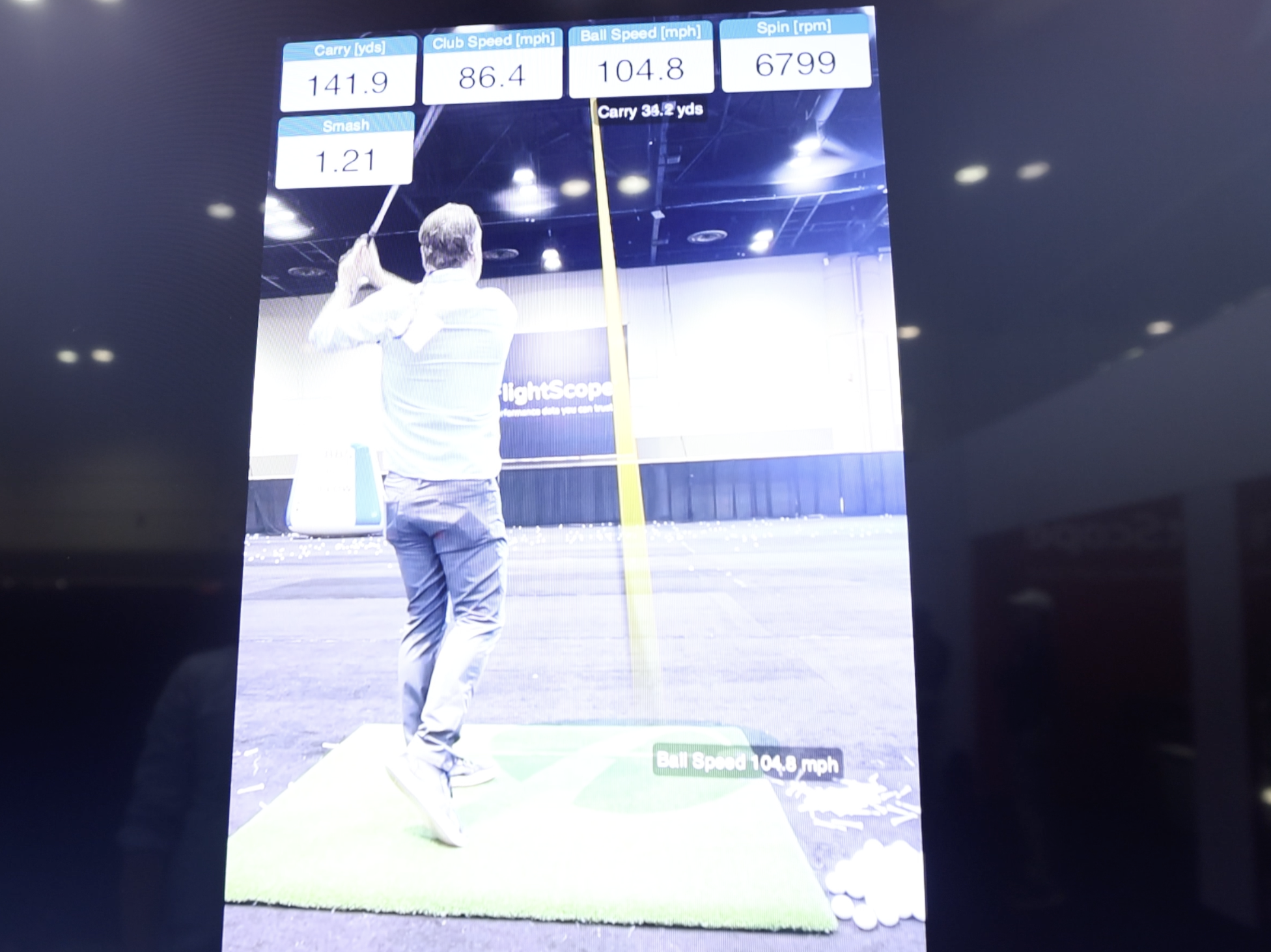
But here’s the catch: It was a pain to set up.
For over a year, the feature technically existed, but it required a secondary device and a bunch of behind-the-scenes configuration that most people, including me, weren’t willing to deal with. It was easier just to look at the virtual tracer in the app, even if it didn’t show you your actual swing.
So it became one of those features that sounded amazing on paper, but in practice, barely anyone used.
That’s now changed.
With a recent update, FlightScope has made Live Shot Tracer way easier to use. Setup is now integrated right into the app, and the whole process is streamlined. It’s now a really useful feature that’s a lot more usable.
You can record live swing video with a shot tracer overlay, plus key stats like carry distance, peak height, and ball speed, all displayed right in the video on top of the tracer line. It’s slick, and it adds a level of visual feedback that’s totally unique.
Bonus: Custom Trajectory Colors
Alongside the shot tracer upgrade, FlightScope also added a small but helpful customization feature: You can now assign different trajectory colors to different clubs during your sessions. So your 7-iron shots can show one color, your 8-iron another, and so on.
It’s a subtle upgrade, but for visual learners or anyone doing deep club comparison work, it makes your range sessions easier to analyze at a glance.
Maximum Versatility
Both of these devices — the Mevo+ and the X3C — keep getting better years after their release. And not in small ways either. We’re talking major feature additions.
But here’s the kicker: They’re doing it without asking you to pay any subscription cost.
That’s rare in both the golf and tech spaces.
One of the things that continues to make these devices great is their versatility. Whether it’s with your PC, your iPhone, or your Apple Watch, you’ve got so many options.
(Yes, you can get your shot data on your Apple Watch and it works great.)
Also, both devices are compatible with every major third-party simulator software option.
Beyond that, you’ve got so many opportunities, including:
- Multi-camera swing video setup
- Gamified practice
- Bag Mapping
- FlightScope i4 rangefinder compatibility, allowing you to get on-course club recommendations based on your launch monitor data
All without a subscription. All without a new device. It’s all just included.
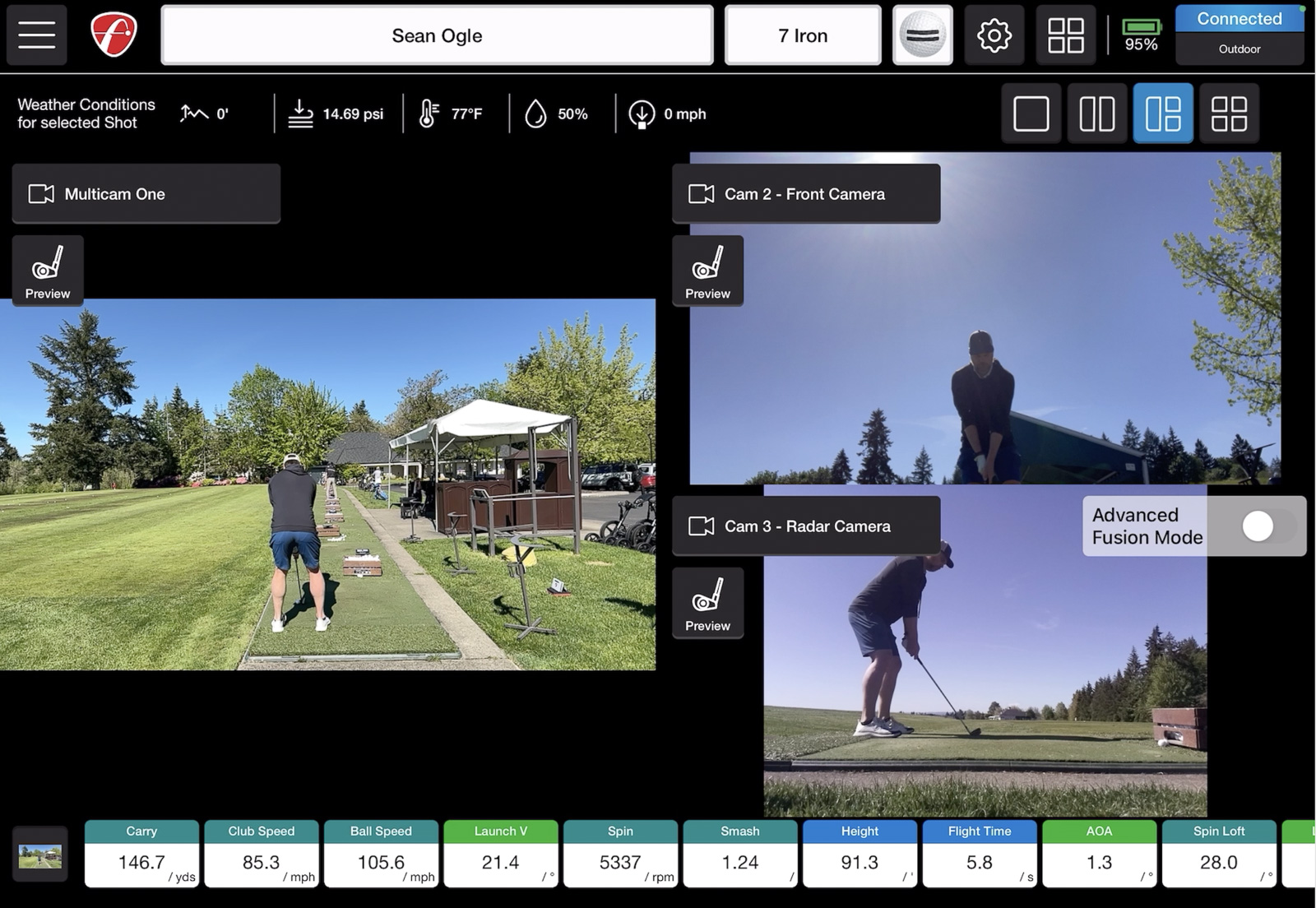
This kind of product longevity and support is a big part of why these two launch monitors remain so compelling, no matter which one you’re looking at.
So, Should You Buy the FlightScope X3C?
If you’ve already bought into the FlightScope ecosystem and if the flexibility and added features that I’ve mentioned are what matter most to you, then, yes, this is absolutely a device worth considering.
Especially if you’re a club professional, a fitter, or you’re building out a high-end simulator setup at home and want something serious without Trackman-level money.
But for 95% of people reading this? The Mevo+ remains the way to go. It delivers nearly everything the X3C offers at a fraction of the price, and it keeps getting better with free updates.
Still, if you’re after the most accurate numbers, want an easier setup process, and need that full-scale pro-level capability — with no ongoing subscription required — the X3C delivers all of that and then some.
There's absolutely no denying that the FlightScope X3C is an incredible launch monitor. The question though: Is it really more than $10K better than the also-awesome FlightScope Mevo+?
This page contains affiliate links. This means that if you click a link and buy one of the products on this page, we may receive a commission (at no extra cost to you!) This doesn’t affect our opinions or our reviews. Everything we do is to benefit you as the reader, so all of our reviews are as honest and unbiased as possible.
The Mevo+ sets a high bar, but the X3C clears it for a certain kind of golfer.
The FlightScope X3C is one of the most capable, versatile, and future-proof launch monitors you can buy. It's not cheap, and for most golfers the Mevo+ remains the better value. But if you're a serious coach, clubfitter, or competitive player, this might be a really smart buy.
The Good
- Subscription-free
- Tracks full ball flight outdoors
- More putting and short game data than the Mevo+
- Same app as the Mevo+, with all data history preserved
- Auto-leveling makes setup a breeze
The Bad
- Still a mini USB connection
- Costs $10K+ more than the Mevo+
- Shot feedback is a bit slower than Mevo+
- App design is feeling slightly dated
-
Presentation
-
Performance
-
Features and Quality
-
Price
-
Personal Affinity

